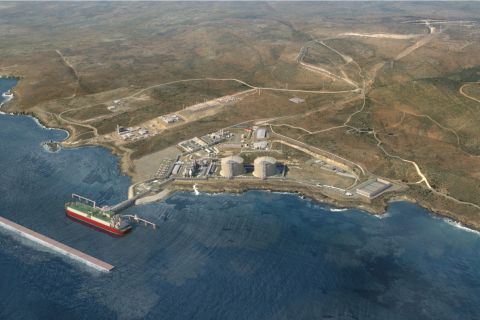Producers are trying to position themselves to take full advantage of higher gas prices when they arrive later this year, according to their presentations at Banc of America Securities LLC's annual energy conference recently. If anything, longer-term supply fundamentals have improved, maintains Mark Papa, chairman and chief executive officer of EOG Resources Inc. The company now expects U.S. gas production to fall 5% or 6% during 2002. The forecast is up from its earlier prediction of 3% or 4%. "When second-quarter results for publicly traded companies are totaled, deliverability will have dropped 5% year-to-year," Papa says. "By the fourth quarter, supplies probably will fall 4 billion cubic feet (Bcf) per day, or about 7%. In 2003, we expect production to fall 2% to 3% versus 2002, even with robust drilling activity. There's a storage overhang in the short run that we expect to disappear by November. After that, it should get interesting." Most producers curb spending when commodity prices drop. EOG uses a countercyclical strategy. "We're purposely overspending our cash flow this year because we think we can get things done more cheaply. Even so, we could end the year with the lowest ratio of debt to total equity of our peer group. "If service costs start to come up, we might see a little bit of a squeeze. We've tried to mitigate them by linking them to a gas-price index so the companies that supply our services benefit from our higher cash flow as commodity prices improve." EOG's 2002 capital outlay should total $750 million. The company spent $1 billion last year, an amount that its CEO now considers excessive by about $150 million. EOG's board will meet during the third quarter to discuss its capital strategy in the next up-cycle. Papa says he favors limiting spending to $850 million and using the balance to reduce debt and buy back shares. Other producers are warning of an impending North American gas-supply squeeze. "I think it's going to be an increasingly scarce commodity," says XTO Energy Inc. chairman and CEO Bob Simpson. "The national decline rate is approaching 25%. At 20%, most of the supply that exists today will be gone in a decade without new projects." The decline rate that the industry faces today is about double what it was 15 years ago, he adds. "We're on a treadmill. Supplies were virtually flat the last decade. Last year, when about 950 rigs were drilling for gas-about double what it was four or five years ago-production was about flat. At a little over 700, this year's rig count is about a third lower than what it was last year. If we don't start drilling faster soon, we'll see declines increase by 7% or 8%." XTO started 2002 with a $400-million capital budget that did not include acquisitions. It probably will spend around $350 million, including some carryover from 2001. The company also completed $164 million worth of property acquisitions July 1, pushing its gas production beyond 500 million cubic feet (MMcf) per day. Cabot Oil & Gas Corp. also is optimistic about long-term gas prospects, according to Dan Dinges, chairman, president and CEO. "Our plans this year are to focus on higher-rate-of-return prospects on the Gulf Coast and in the Rocky Mountains," he says. "We will remain proactive in our acquisition efforts, but don't plan to be out there buying for the sake of buying. We also are looking for a good entry point onto the Gulf Shelf." The company also plans to strengthen its balance sheet. In 1995, its total debt-to-capitalization ratio was 86%. At year-end 2001, it 55%. "Financial discipline is our main driver this year." It expects risk management, including hedging some production, to remain a consistent part of its overall program to mitigate price volatility. Burlington Resources Inc. also hedges some of its production. "We use it to reduce risk and improve returns. But we see it as a supplement to running our core business well," says Steven Shapiro, senior vice president and chief financial officer. The company's assets give it a dominant position in North America's largest gas play from New Mexico's San Juan Basin to western Canada. In addition to 11 trillion cubic feet (Tcf) of proven reserves, it controls significant unproven resources. "We have exposure to high-impact plays that do not require significant amounts of up-front capital. We hope to move fairly quickly to achieve our near-term goal of reducing our debt-to-capital ratio to between 40% and 45%," says Shapiro. "By shifting our portfolio away from deeply declining assets in the shallow Gulf of Mexico, we have flattened our decline rate from 20% per year. Essentially, we are spending about $900 million to $1 billion to keep declines flat from our core areas." Drilling contractors and service and supply companies also are determined to do more than simply weather cyclical downturns. "We have tried to strengthen our company during recessionary times with acquisitions and initiatives so we can maximize earnings during each recovery," says Bill Stewart, president and CEO of BJ Services Co. Christopher T. Seaver, president and CEO of Hydril Co. Inc., says, "We are getting to the end of inventory in America now. Purchases will dominate from now on, and demand will exceed supply as inventories are built back up."
Recommended Reading
Midstream Builds in a Bearish Market
2024-03-11 - Midstream companies are sticking to long term plans for an expanded customer base, despite low gas prices, high storage levels and an uncertain political LNG future.
Heard from the Field: US Needs More Gas Storage
2024-03-21 - The current gas working capacity fits a 60 Bcf/d market — but today, the market exceeds 100 Bcf/d, gas executives said at CERAWeek by S&P Global.
Turning Down the Volumes: EQT Latest E&P to Retreat from Painful NatGas Prices
2024-03-05 - Despite moves by EQT, Chesapeake and other gassy E&Ps, natural gas prices will likely remain in a funk for at least the next quarter, analysts said.
Permian Gas Finds Another Way to Asia
2024-04-30 - A crop of Mexican LNG facilities in development will connect U.S. producers to high-demand markets while avoiding the Panama Canal.
US Natgas Prices Hit 5-week High on Rising Feedgas to Freeport LNG, Output Drop
2024-04-10 - U.S. natural gas futures climbed to a five-week high on April 10 on an increase in feedgas to the Freeport LNG export plant and a drop in output as pipeline maintenance trapped gas in Texas.




